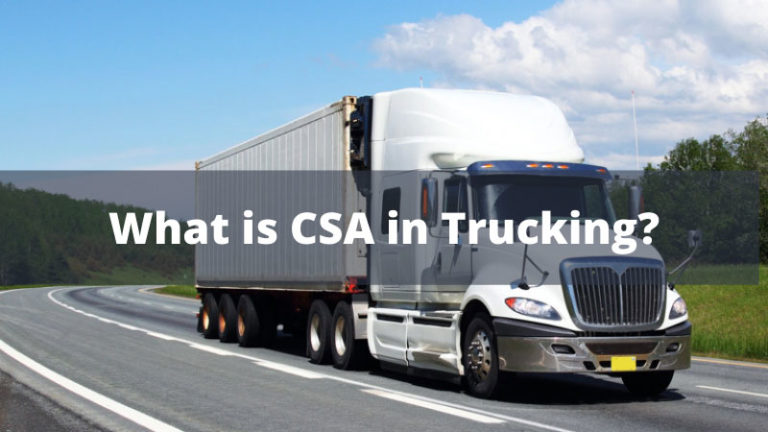Trucking means driving massive carriers by drivers and sharing the lanes with millions of other motorists. However, it also indicates there are probable risks of crashes with other vehicles.
These crashes pose no minor injuries or damages either. As a result, the FMSCA formed the CSA program – Compliance, Safety, Accountability – to act as an intervention.
It ensures the minimization of accidents by intervening via Safety Measurement System (SMS). Every time a vehicle has a record of an incident or inspection, the SMS uses the data to update it onto the DOT number you have.
This is only the tip of an iceberg. You must continue to understand the whole concept of the CSA.
CSA BASIC Classifications
The seven categories below point to the trucking companies and the driver to comply with them. Usually, the SMS weighs the recent incidents that heavily occurred within the 24 months.
1. Unsafe Driving
This BASIC category contains violations like texting/inattentive when driving, speeding, talking on the phone handheld, wrong lane changes, etc.
Generally, it depends on the state officials to give a citation or a spoken warning. The violation shall be in the SMS regardless.
2. Hours of Service Compliance
In FMCSA, there is compliance about how many hours of driving/service is within the jurisdiction. The driver falsifying the duty status (RODs) every 24-hour will face this violation.
Plus, driving more hours than stated is also comprised in this category.
3. Driver Fitness
It practically consists of all the files about the carrier driver. From the qualifications, CDLs to the medical documentation, the Driver Fitness BASIC will have them all.
Even the driving records and their annual reviews should be there alongside the employment history. Everything must be up-to-date during an inspection, or the driver remains unfit to haul a carrier.
4. Controlled Alcohol & Substances
This BASIC operates with the violations regarding under-influence driving. If the driver fails the drug or alcohol test shall face several points in the CSA score.
The violation also consists of illegal drug possessions that have not been prescribed. Plus, misusing the prescribed medication and OTC (Over-the-Counter) medication fall in this category as well.
5. Vehicle Maintenance
Here the record shows vehicle inspections made before or after a trip. It also mentions whether there was any defect and if it was fixed on time.
Violating minor maintenance like broken tail/headlights, old tires, dangerous cargo securing, braking issues, etc. too is considered in the Vehicle Maintenance BASIC. Read details
6. Hazardous Material Compliance
If you transport HAZMAT cargo, it should always be maintained followed by a set of rules. Failing to comply with these regulations will face this BASIC violation.
These rules include the proper labeling, packaging, marking, and loading. Furthermore, the SMS data presents the poor tank testing record that is prone to leaks, risky load/unload of the HAZMAT goods, failure in following the rules, etc.
7. Crash Indicator
Any crash that involves injury, vehicle damage, or fatality will be reported. Thus, the data will show its record on the system. Even a vehicle that requires moving from the place of the crash under Crash Indicator BASIC.
The violation point will be considered based on the severity of the crash. However, it is still uncertain how to classify the role of the driver during the report.
CSA Score Based on BASIC Violations Examples
So how do you know if your CSA scores are bad? As the SMS gathers all the data of the recent events, it assigns each carrier to a rank from 0 to 100.
The higher the percentile numbers you get on the scale, the worse the carrier state is. However, facing 2+ violations within at least three inspections indicates a higher risk.
But facing similar violations within seven to ten overall inspections does not relay higher ranks in percentile.
Still, here are some examples of how FMCSA weighs the violations under certain points.
5-Point
You get five points upon tailing too close, changing lanes improperly, disobeying traffic laws. More examples include choosing a route that entails driving over the stated speed limit and not slowing down/stopping near a railway crossing.
Few other violations give you five points, but these are the major ones.
6-Point
Driving with a broken headlight, brake/tail, or signal lights is a point six violation. Even if one of these does not operate and you continue trucking in this manner, there will be citations.
It is applicable for unnoticed reflectors or lights as well.
7-Point
This is one of the severe violations SMS gathers. You will face issues when not wearing a seatbelt, going an additional 11 to 14 MPH over the speed limit, etc.
Being pressured or voluntarily driving more hours than agreed, altering/recording false RODs also falls under the seven-point violation.
Of course, if you fail to present any documents to support your falsified claims will also get seven points.
8-Point
Driving without a CDL permit is a serious violation. It regards the carrier driver unfit for the job.
10-Point
Any usage of a handheld cell phone on duty (driving) or texting when operating a commercial vehicle is a ten-point violation. It also includes speeding way over the limit (15+ MPH), driving irresponsibly, and not slowing down near the construction zones.
Affects in Trucking Business due to CSA Score
These points imposed on the carriers negatively impact the trucking companies. Three major ones are explained below.
Low Profits
Shippers do not often have the accessibility of the SMS data, but the ones available for the public still conveys amply. So they will want to pick a company that does not look bad with high CSA scores.
If the trucking company you work at or own fails to provide reliable haulers, you might face a decline in selection and profit.
Risk of Investigation
There are risks of FMCSA intervention the worse the CSA score gets. Facing investigations can be stressful and intense for the major cases.
The outcome sometimes might even put your business unserviceable too.
Insurance
A trucking company will have to go through a lot of insurance hassles as well. One of them is having to pay steep premiums after the CSA score assessment. Of course, this result is determined by how risky the carrier scores appear.
Ways to Improve CSA Score
Taking measures to improve the scores in the data can prevent confronting severe consequences. So how does one do that?
- Implement Pre-employment Screening Program (PSP) reports when hiring. It aids in minimizing on-road incidents by the apt drivers chosen via smart decisions.
- It is better to maintain the vehicle pre-trip to avoid Vehicle Maintenance Violation. Identify and fix the minor matters so that it does not turn out anything major afterward.
- Use a dual-facing dashcam in a carrier. It will keep a record of both roads and the driver. This might become crucial evidence to ensure and correct violation when imposed – e.g., proper seatbelt usage, hard brake footage, etc.
- It is not entirely improbable that SMS data is entered incorrectly, which led to higher CSA scores. So one must question it via DataQ Process to revise the violation.
- The best way to avert Hours of Service Violation is by using the proper Electronic Logging Device (ELD). It automatically tracks the driver’s RODs. This will reduce errors and simplify the monitoring process.
Final Words
So what is CSA in trucking? It is the means to prevent serious accidents with the help of the FMCSA. Remember that CSA scores are not for the drivers but for the carriers.
It is the hauler that should be safe to drive to make sure both the public and the driver feels at ease around the vehicle. Of course, this does not mean you can get away with a violation record.
There is a pre-screening system in most trucking companies that keep tabs on your driving history. So, always drive safely and follow the regulation to avoid charges.


